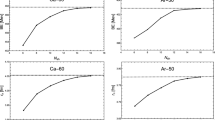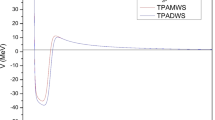Abstract
In this work we derive analytically a real \(\alpha+\alpha\) potential using the JLM effective nucleon–nucleon (NN) interaction. The aim is to obtain analytically self-energy dependent \(\alpha+\alpha\) effective interaction. We used two different overlapping local density approximations, (geometrical and arithmetic averages, respectively) in JLM parameterization. The derived real potentials in companion with phenomenological Wood–Saxon (WS) imaginary potential are tested in the analysis of the elastic scattering of \(\alpha+\alpha\), over a wide range of energy and angular distribution. The analysis is performed in the framework of optical model for several sets of data measured at three different ranges of energies, 6.5–18, 40.8–47.3, and 100–280 MeV. The predictions of the calculated potentials are satisfactory in reproduction of experimental data. We conclude that both analyticaly derived potentials provide successful description of the experimental data.







Similar content being viewed by others
REFERENCES
T. Furumoto and Y. Sakuragi, Phys. Rev. C 74, 034606 (2006). https://link.aps.org/doi/10.1103/PhysRevC.74.034606
J. S. McCarthy, I. Sick, and R. R. Whitney, Phys. Rev. C 15, 1396 (1977). https://link.aps.org/doi/10.1103/PhysRevC.15.1396
P. E. Hodgson, Z. Phys. 349, 197 (1994). https://doi.org/10.1007/BF01288959
Jun Hiura and Ryozo Tamagaki, Prog. Theor. Phys. Suppl. 52, 25 (1972). http://dx.doi.org/10.1143/PTPS.52.25
M. Rahman, D. Husain, and S. Ali, Phys. Rev. C 10, 1 (1974). https://link.aps.org/doi/10.1103/PhysRevC.10.1
Albert Lumbroso, Phys. Rev. C 10, 1271 (1974). https://link.aps.org/doi/10.1103/PhysRevC.10.1271
Ronald E. Brown and Y. C. Tang, Phys. Rev. C 14, 1675 (1976). https://link.aps.org/doi/10.1103/PhysRevC.14.1675
J. Thaler, Phys. Rev. C 32, 2189 (1985). https://link.aps.org/doi/10.1103/PhysRevC.32.2189
N. P. Heydenburg and G. M. Temmer, Phys. Rev. 104, 123 (1956). https://link.aps.org/doi/10.1103/PhysRev.104.123
T. A. Tombrello and L. S. Senhouse, Phys. Rev. 129, 2252 (1963). https://link.aps.org /doi/10.1103/PhysRev.129.2252
Luis Marquez, Phys. Rev. C 28, 2525 (1983). https://link.aps.org/doi/10.1103/PhysRevC.28.2525
V. G. Neudatchin, V. I. Kukulin, V. L. Korotkikh, and V. P. Korennoy, Phys. Lett. B 34, 581 (1971). http://www.sciencedirect.com/science/article/pii/0370269371901420.
B. Buck, H. Friedrich, and C. Wheatley, Nucl. Phys. A 275, 246 (1977). http://www.sciencedirect.com/science/article/pii/0375947477902871.
P. Darriulat, G. Igo, H. G. Pugh, and H. D. Holmgren, Phys. Rev. 137, B315 (1965). https://link.aps.org/doi/10.1103/PhysRev.137.B315
A. Nadasen, P. G. Roos, B. G. Glagola, G. J. Mathews, V. E. Viola, H. G. Pugh, and P. Frisbee, Phys. Rev. C 18, 2792 (1978). https://link.aps.org/doi/10.1103/PhysRevC.18.2792
A. A. Cowley, G. F. Steyn, S. V. For̈tsch, J. J. Lawrie, J. V. Pilcher, F. D. Smit, and D. M. Whittal, Phys. Rev. C 50, 2449 (1994). https://link.aps.org/doi/10.1103/PhysRevC.50.2449
G. F. Steyn, S. V. For̈tsch, J. J. Lawrie, F. D. Smit, R. T. Newman, A. A. Cowley, and R. Lindsay, Phys. Rev. C 54, 2485 (1996). https://link.aps.org/doi/10.1103/PhysRevC.54.2485
G. F. Steyn, S. V. For̈tsch, A. A. Cowley, S. Karataglidis, R. Lindsay, J. J. Lawrie, F. D. Smit, and R. T. Newman, Phys. Rev. C 57, 1817 (1998). https://link.aps.org/doi/10.1103/PhysRevC.57.1817
K. A. G. Rao, A. Nadasen, D. Sisan, W. Yuhasz, D. Mercer, Sam M. Austin, P. G. Roos, and R. E. Warner, Phys. Rev. C 62, 014607 (2000). https://link.aps.org/doi/10.1103/PhysRevC.62.014607.14
E. W. Schmid and K. Wildermuth, Nucl. Phys. 26, 463 (1961). http://www.sciencedirect.com/science/article/pii/0029558261901055.
G. R. Satchler and W. G. Love, Phys. Rep. 55, 183 (1979). http://www.sciencedirect.com/science/article/pii/0370157379900814.
M. Avrigeanu, W. von Oertzen, A. J. M. Plompen, and V. Avrigeanu, Nucl. Phys. A 723, 104 (2003).
F. E. Steigert and M. B. Sampson, Phys. Rev. 92, 660 (1953). https://link.aps.org /doi/10.1103/PhysRev.92.660
W. S. Chien and Ronald E. Brown, Phys. Rev. C 10, 1767 (1974). https://link.aps.org/doi/10.1103/PhysRevC.10.1767
M. El-Azab Farid, Phys. Rev. C 74, 064616 (2006). https://link.aps.org/doi/10.1103/PhysRevC.74.064616
J. P. Jeukenne, A. Lejeune, and C. Mahaux, Phys. Rev. C 16, 80 (1977). https://link.aps.org/doi/10.1103/PhysRevC.16.80
M. N. A. Abdullah, M. S. Sabra, M. M. Rashid, Z. Shehadeh, M. M. Billah, S. K. Das, M. A. Uddin, A. K. Basak, I. Reichstein, H. M. Sen Gupta, and F. B. Malik, Nucl. Phys. A 775, 1 (2006). http://doi:10.1016/j.nuclphysa.2006.06.007
Zakaria M. M. Mahmoud, Awad A. Ibraheem, and M. El-Azab Farid, J. Phys. Soc. Japan 81, 124201 (2012). https://doi.org/10.1143/JPSJ.81.124201
J. S. Al-Khalili, J. A. Tostevin, and I. J. Thompson, Phys. Rev. C 54, 1843 (1996). https://link.aps.org/doi/10.1103/PhysRevC.54.1843
N. M. Clarke, Hi-OPTIM94.2 code Univ. of Birmingham, private communication.
T. Furumoto, Y. Sakuragi, and Y. Yamamoto, Phys. Rev. C 90, 041601 (2014). https://link.aps.org/doi/10.1103/PhysRevC.90.041601
T. Furumoto, Y. Sakuragi, and Y. Yamamoto, Phys. Rev. C 94, 044620 (2016). https://link.aps.org/doi/10.1103/PhysRevC.94.044620
ACKNOWLEDGMENTS
The authors extend their appreciation to the Deanship of Scientific Research at King Khalid University for funding this work through research groups program under grant no. R.G.P.1/124/40.
Author information
Authors and Affiliations
Corresponding author
Rights and permissions
About this article
Cite this article
Mahmoud, Z.M., Hassanien, M.A. Analytical \(\boldsymbol{\alpha}\boldsymbol{+}\boldsymbol{\alpha}\) Potential for Energy Range between 6 and 280 MeV. Phys. Atom. Nuclei 83, 418–430 (2020). https://doi.org/10.1134/S106377882003014X
Received:
Revised:
Accepted:
Published:
Issue Date:
DOI: https://doi.org/10.1134/S106377882003014X




